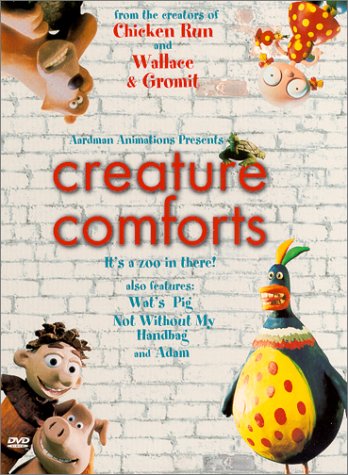 CREATURE COMFORTS is the first Oscar-winning film from the unbeatable team of Aardman Animations and director Nick Park. Presented as a documentary, the 1990 stop-motion production features a series of interviews with zoo animals, who express an amusing variety of views regarding their stay in captivity – sometimes hilarious, sometimes poignant.
CREATURE COMFORTS is the first Oscar-winning film from the unbeatable team of Aardman Animations and director Nick Park. Presented as a documentary, the 1990 stop-motion production features a series of interviews with zoo animals, who express an amusing variety of views regarding their stay in captivity – sometimes hilarious, sometimes poignant.
Much of the humor derives from the casting of the animal characters to match the pre-recorded voices. CREATURE COMFORTS, which took home an Academy Award in the Animated Short Subject category, features claymation creatures (technically, plasticine) whose lip movements are synchronized with unscripted dialogue recorded live via interviews with people asked about living conditions in England. Putting these words in the mouths of animated animals, suggests some interesting parallels between the human condition and living life in a cage: A gorilla complains about the cold, wet climate. A koala bear feels very looked after by his keepers. The highlight is a puma, obviously feeling confined in his pen, who keeps repeating the word “space” as he years for wide-open terrain.
The animation, with its exaggerated lip movements to match the human enunciation, delivers perfect performances that bring the characters to life as they struggle to make their point for the camera. The psuedo-documentary format results in a talking-heads style of filmmaking, but Park adds a few visual flourishes, in the form of sight gags taking place in the background. The result is a delightful short subject with as much entertainment and artistic value as many feature-length films.
DVD DETAILS
Now out of print, Image Entertainment’s 2000 DVD combines CREATURE COMFORTS with three other titles from Aardman Animations: WAT’S PIG, NOT WITHOUT MY HANDBAG, and ADAM. CREATURE COMFORTS is presented in a 1.85 transfer enhanced for widescreen TVs; the other films are presented in full-frame 1.33 transfers. There are no bonus features. CREATURE COMFORTS is the highlight of the four, but the other films are all remarkable and entertaining in their own right.
WAT’S PIG, written and directed by Peter Lord, is an amusing prince-and-the-pauper type tale of identical twins separated at birth. The story, which is presented as a sort of mini-epic, is told without more than a word or two of dialogue, with a split screen detailing the lives of the two boys as they grow up and eventually meet when the peasants rise up and storm the local castle. The ambitious film was nominated in the Animated Short category in 1996.
NOT WITHOUT MY HANDBAG – written and directed by Boris Kossmehl, with an assist on the script from Andrea Friedrich – is a mondo-weird, almost psychedelic story about what happens when a woman misses a payment on a home appliance: according to the fine print, she forfeits her soul, which is dragged to hell. However, the woman just can’t rest quietly without her handbag back on Earth, so she returns to the land of the living to reclaim it. Fortunately, her neice is not too alarmed by the unexpected reappearance (“My aunt is a zombie from Hell,” she observes casually”). Despite the Aardman pedigree, and the bright colors, NOT WITHOUT MY HANDBAG feels a bit like something from Tim Burton and/or Henry Selick. If you dig NIGHTMARE BEFORE CHRISTMAS or CORALINE, you should get a kick out of this.
ADAM is another Oscar nominated Animated Short from Peter Lord. Presented with a tongue-in-cheek simulation of awe, the film depicts what happens when the hand of God (or more accurately, the stop-motion animator) fashions a lump of clay into the first man, and then creates a companion for him (though not quite the companion that was expected).


